10 Critical Features of a Successful Data Governance Program
Data serves as the backbone of every modern organization. Effective Data Governance ensures that your data remains accurate, consistent, and reliable. It establishes clear policies and practices for managing data, enabling you to make informed decisions with confidence. Without it, organizations risk data silos, errors, and compliance issues. By implementing the right Ingredients of Data Governance, you can protect sensitive information, enhance operational efficiency, and build trust with stakeholders. This approach not only safeguards your data but also unlocks its true value, driving sustainable growth and innovation.

Key Takeaways
Establish a clear data governance framework to enhance transparency, accountability, and alignment with business goals.
Secure executive sponsorship to drive the vision and resource allocation for your data governance initiatives.
Define roles and responsibilities for data stewardship to foster accountability and ensure effective data management.
Implement comprehensive data policies and standards to maintain order, compliance, and protect sensitive information.
Prioritize data quality management by focusing on accuracy, consistency, and completeness to support informed decision-making.
Adopt robust data security measures and ensure compliance with regulations like GDPR and CCPA to protect sensitive data.
Invest in training and change management to build a data-driven culture and empower employees in their data governance roles.
Clear Data Governance Framework
A clear data governance framework serves as the foundation for managing your organization's data effectively. It provides a structured approach to ensure consistency, accountability, and alignment with business goals. Without a defined framework, you risk data mismanagement, inefficiencies, and compliance challenges.
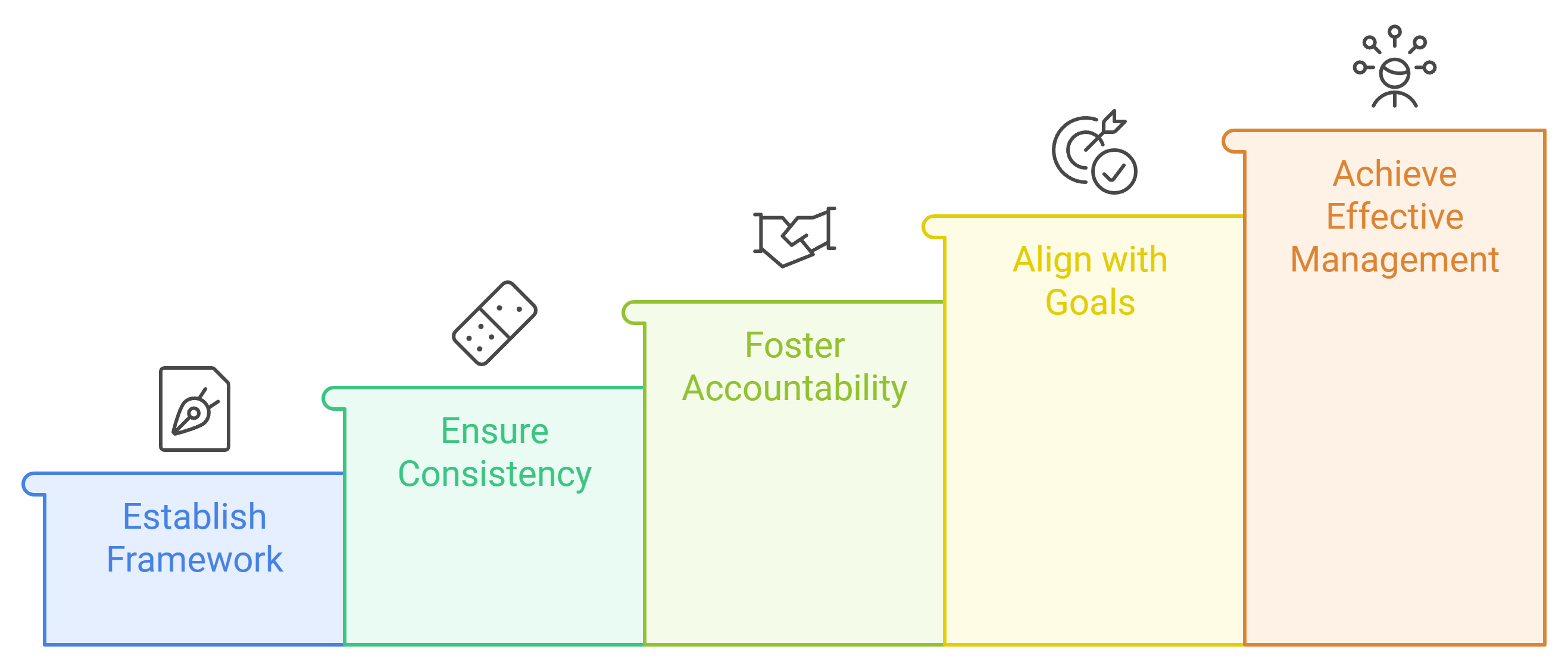
Importance of a Defined Framework
A well-defined framework brings numerous benefits to your organization. It enhances transparency by establishing clear rules and guidelines for data usage. This transparency fosters collaboration among teams, ensuring everyone works toward shared objectives. A robust framework also improves data quality, enabling you to make accurate and informed decisions. Additionally, it helps mitigate risks by addressing potential vulnerabilities in data management processes.
Organizations with clear governance frameworks experience better operational efficiency, improved trust, and stronger compliance with regulations like GDPR. In contrast, those without such frameworks often struggle with data silos, errors, and privacy concerns.
By implementing a framework, you create a centralized system for managing data. This centralization ensures consistency and reduces confusion, making it easier to maintain high standards across the organization.
Key Components of a Governance Framework
To build an effective framework, you need to focus on several key components:
Policies and Standards: Define clear policies for data collection, storage, and usage. Establish standards to ensure consistency and compliance.
Roles and Responsibilities: Assign specific roles, such as data stewards and data owners, to oversee data management and accountability.
Processes and Workflows: Develop workflows for data access, sharing, and maintenance. These processes should align with your organization's goals.
Technology and Tools: Leverage data governance tools to automate processes, monitor compliance, and manage metadata effectively.
Monitoring and Auditing: Implement mechanisms to track performance and conduct regular audits to identify areas for improvement.
Each component plays a critical role in ensuring your data governance framework remains effective and adaptable to changing needs.
Tips for Establishing a Framework
Creating a data governance framework may seem daunting, but following these tips can simplify the process:
Start Small: Focus on a specific area or department to pilot your framework. Gradually expand it across the organization.
Engage Stakeholders: Involve key stakeholders, including executives and team leaders, to gain support and ensure alignment with business objectives.
Document Everything: Clearly document policies, roles, and processes. This documentation serves as a reference for all employees.
Provide Training: Educate your team on the importance of data governance and their roles within the framework.
Review Regularly: Continuously evaluate and update your framework to address new challenges and opportunities.
By following these steps, you can establish a framework that supports effective data governance and drives long-term success.
Executive Sponsorship and Leadership Support
Strong leadership plays a pivotal role in the success of any data governance program. Without executive sponsorship, your efforts may lack direction, resources, and organizational alignment. Leaders set the tone for how data is valued and managed across the organization. Their involvement ensures that data governance becomes a strategic priority rather than an afterthought.
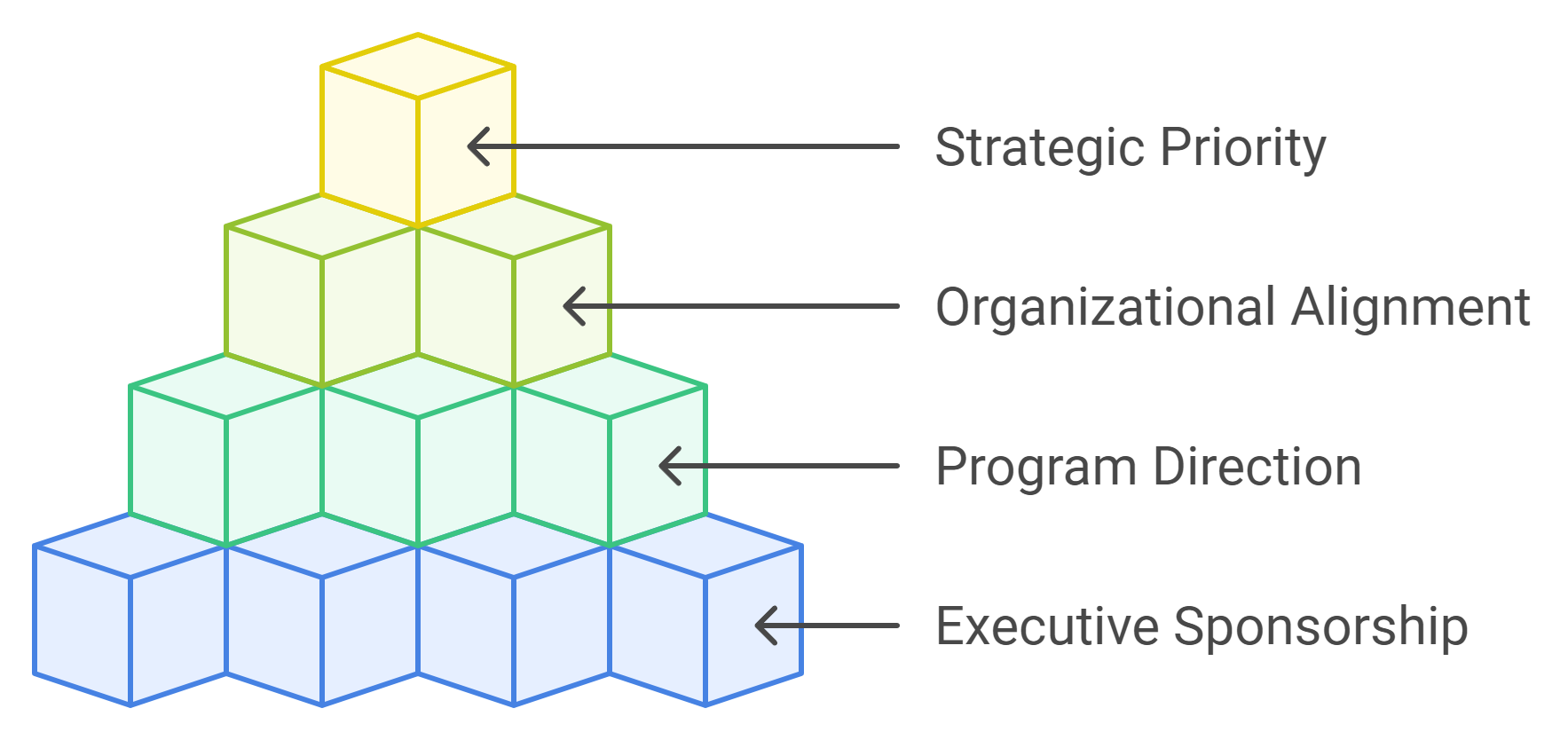
Role of Leadership in Effective Data Governance
Leadership drives the vision and purpose of data governance initiatives. Executives provide the authority needed to implement policies and enforce compliance. They also allocate resources, such as funding and personnel, to support the program. When leaders actively participate, they inspire teams to prioritize data governance and align their efforts with organizational goals.
"Leadership is not about being in charge. It is about taking care of those in your charge." This quote by Simon Sinek highlights the importance of leaders fostering a culture of accountability and collaboration.
You need leaders who understand the value of data as a strategic asset. Their guidance ensures that data governance aligns with business objectives, enabling you to achieve measurable outcomes.
Benefits of Executive Buy-In
Securing executive buy-in offers several advantages for your data governance program:
Increased Credibility: Leadership endorsement gives your program legitimacy, making it easier to gain support from other stakeholders.
Resource Allocation: Executives can secure budgets, tools, and personnel necessary for implementing and sustaining the program.
Organizational Alignment: Leaders help bridge gaps between departments, ensuring everyone works toward shared data governance goals.
Faster Decision-Making: With leadership support, you can address challenges and implement changes more efficiently.
Cultural Shift: Leaders influence organizational culture, promoting data-driven decision-making and accountability.
When executives champion data governance, they create an environment where teams feel empowered to manage data responsibly and effectively.
Strategies for Gaining Leadership Support
Convincing executives to support data governance requires a strategic approach. Here are some actionable strategies:
Present a Business Case: Highlight how data governance addresses specific challenges, such as compliance risks or inefficiencies. Use real-world examples to demonstrate potential benefits.
Showcase ROI: Quantify the return on investment by linking data governance to cost savings, improved decision-making, or enhanced customer trust.
Align with Strategic Goals: Connect data governance initiatives to broader organizational objectives, such as digital transformation or market expansion.
Leverage Metrics: Use data to illustrate current gaps in data quality, security, or compliance. Show how governance can close these gaps.
Engage Early: Involve executives from the beginning. Seek their input and keep them informed about progress and milestones.
Highlight Risks: Emphasize the consequences of poor data governance, such as regulatory fines or reputational damage. Stress the importance of proactive measures.
By following these strategies, you can secure the leadership support needed to build and sustain an effective data governance program.
Data Stewardship and Ownership
Data stewardship and ownership form the backbone of a successful data governance program. They ensure that every piece of data within your organization is managed responsibly and effectively. By assigning clear roles and fostering accountability, you can create a culture where data is treated as a valuable asset.
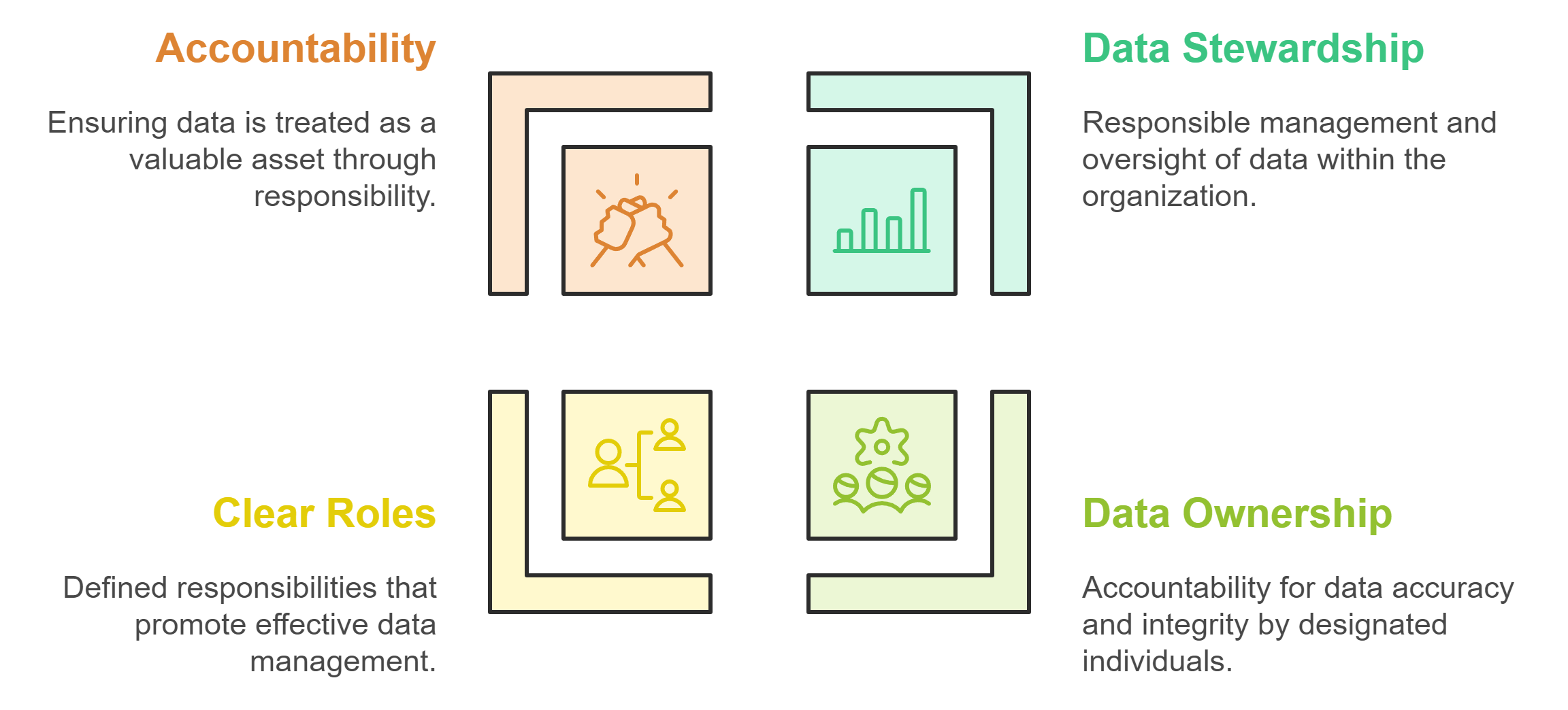
Defining Roles and Responsibilities
Defining roles and responsibilities is the first step toward effective data stewardship. You need to clarify who manages what data and how they should handle it. This clarity eliminates confusion and ensures that everyone understands their part in maintaining data quality.
"Just like knowing who made your sandwich can improve its quality, understanding data stewardship enhances accountability."
Assigning roles such as data stewards, privacy officers, and compliance officers ensures that your data governance policies are consistently followed. Data stewards act as guardians of your data, keeping it accurate, up-to-date, and accessible. Privacy officers focus on protecting sensitive information, while compliance officers ensure adherence to regulations. Together, these roles create a robust framework for managing your organization's data.
Importance of Accountability in Data Management
Accountability is the cornerstone of effective data management. When individuals take ownership of their data responsibilities, they feel empowered to address issues and maintain high standards. Leadership plays a crucial role in fostering this sense of responsibility. By championing the cause of data stewardship, leaders set the tone for a culture of accountability.
A strong sense of ownership ensures that data-related concerns are addressed promptly. For example, if a data steward notices inconsistencies in a dataset, they take immediate action to resolve the issue. This proactive approach minimizes risks and enhances the overall quality of your data.
"Creating a culture of data stewardship and ownership is critical so everyone understands their role in leveraging an organization's data."
When accountability becomes a shared value, your organization benefits from improved data reliability, better decision-making, and stronger compliance with regulations.
Best Practices for Assigning Data Stewards
Assigning data stewards requires a thoughtful approach. Here are some best practices to guide you:
Identify Key Data Areas: Determine which datasets are most critical to your organization. Focus on areas that require close monitoring and management.
Select Qualified Individuals: Choose individuals with the skills and knowledge needed to manage data effectively. Look for team members who understand the importance of data governance.
Define Clear Expectations: Clearly outline the responsibilities of each data steward. Provide guidelines on how they should handle data and address issues.
Provide Training: Equip data stewards with the tools and knowledge they need to succeed. Offer training sessions on data governance policies and best practices.
Foster Collaboration: Encourage data stewards to work closely with other stakeholders, such as IT teams and compliance officers. Collaboration ensures consistency and alignment across the organization.
By following these practices, you can build a team of skilled data stewards who uphold your data governance standards. Their efforts will contribute to a culture of accountability and ensure that your data remains a valuable asset.
Comprehensive Data Policies and Standards
Data policies and standards form the backbone of a robust data governance program. They provide clear guidelines for how data should be collected, stored, accessed, and used. Without these policies, organizations risk non-compliance, inefficiencies, and data misuse. Establishing comprehensive policies ensures consistency and protects sensitive information while aligning with legal and regulatory requirements.
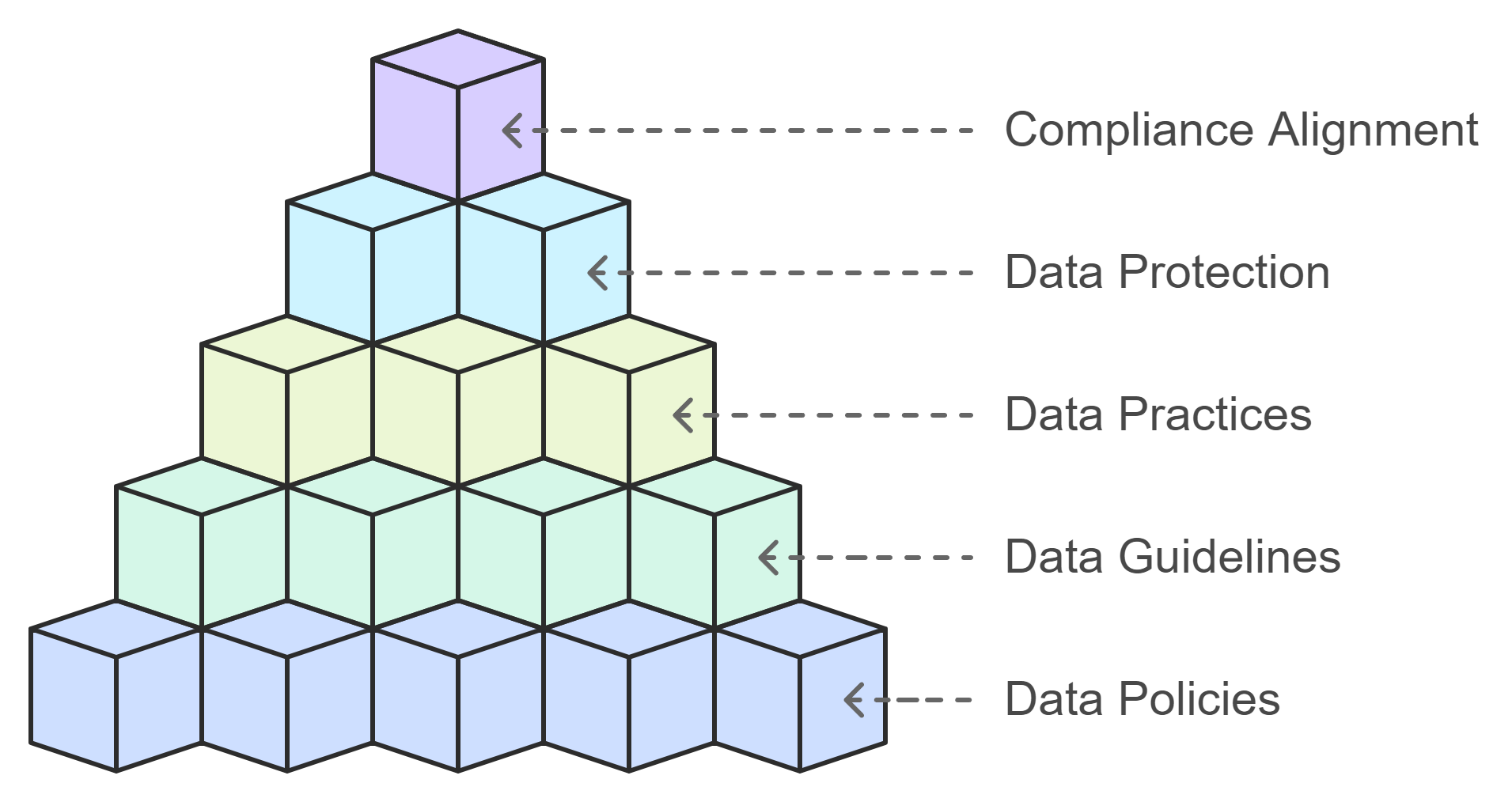
Why Policies and Standards Matter
Policies and standards are essential for maintaining order and accountability in data management. They help you define the rules for handling data, ensuring that everyone in your organization follows the same practices. This consistency reduces errors and enhances trust in your data.
"Strong data policies protect organizations from legal penalties and ensure compliance with regulations like GDPR, HIPAA, and CCPA."
Effective policies also safeguard sensitive information. For example, data protection policies ensure that personal data remains secure and private. These policies help you comply with privacy laws, such as the General Data Protection Regulation (GDPR), which imposes strict requirements on how personal data is handled. By adhering to these standards, you can avoid legal penalties and maintain customer trust.
Moreover, well-defined standards improve operational efficiency. They eliminate ambiguity by providing clear instructions for data-related tasks. This clarity enables teams to work more effectively, reducing delays and miscommunication.
Examples of Effective Data Policies
To create impactful data policies, you can draw inspiration from existing examples. Here are some common types of data policies that organizations implement:
Data Privacy Policies: These policies outline how personal data is collected, used, and shared. They ensure compliance with privacy laws like GDPR, CCPA, and PIPEDA.
Data Security Policies: These focus on protecting sensitive data from breaches. They include measures like encryption, access controls, and regular security audits.
Data Retention Policies: These specify how long data should be stored and when it should be deleted. They help organizations manage storage costs and comply with regulations.
Access Control Policies: These define who can access specific data and under what conditions. They prevent unauthorized access and ensure data integrity.
Data Usage Policies: These provide guidelines for how data can be used within the organization. They prevent misuse and promote ethical practices.
Each of these policies addresses a specific aspect of data governance. Together, they create a comprehensive framework for managing your organization's data responsibly.
Steps to Develop and Enforce Standards
Developing and enforcing data standards requires a structured approach. Follow these steps to ensure success:
Assess Your Needs: Identify the specific challenges and risks your organization faces. Consider factors like regulatory requirements, data sensitivity, and operational goals.
Engage Stakeholders: Involve key stakeholders, such as IT teams, legal advisors, and department heads. Their input ensures that the standards align with organizational needs.
Define Clear Guidelines: Create detailed instructions for data collection, storage, and usage. Use simple language to make the guidelines easy to understand.
Incorporate Legal Requirements: Ensure that your standards comply with relevant laws and regulations. For instance, include provisions for GDPR or HIPAA compliance if applicable.
Implement Monitoring Mechanisms: Use tools to track adherence to the standards. Regular audits help identify gaps and ensure continuous improvement.
Provide Training: Educate employees on the importance of data standards and their role in maintaining them. Training sessions promote awareness and accountability.
Enforce Consequences: Establish consequences for non-compliance. This enforcement ensures that everyone takes the standards seriously.
By following these steps, you can create and maintain data standards that support your organization's goals. These standards will not only enhance data quality but also protect your organization from legal and reputational risks.
Data Quality Management
Data quality management ensures that the information you rely on for decision-making is accurate, consistent, and reliable. Poor data quality can disrupt workflows, lead to errors, and negatively impact your organization’s performance. By prioritizing data quality, you can enhance operational efficiency, build trust, and make better decisions.
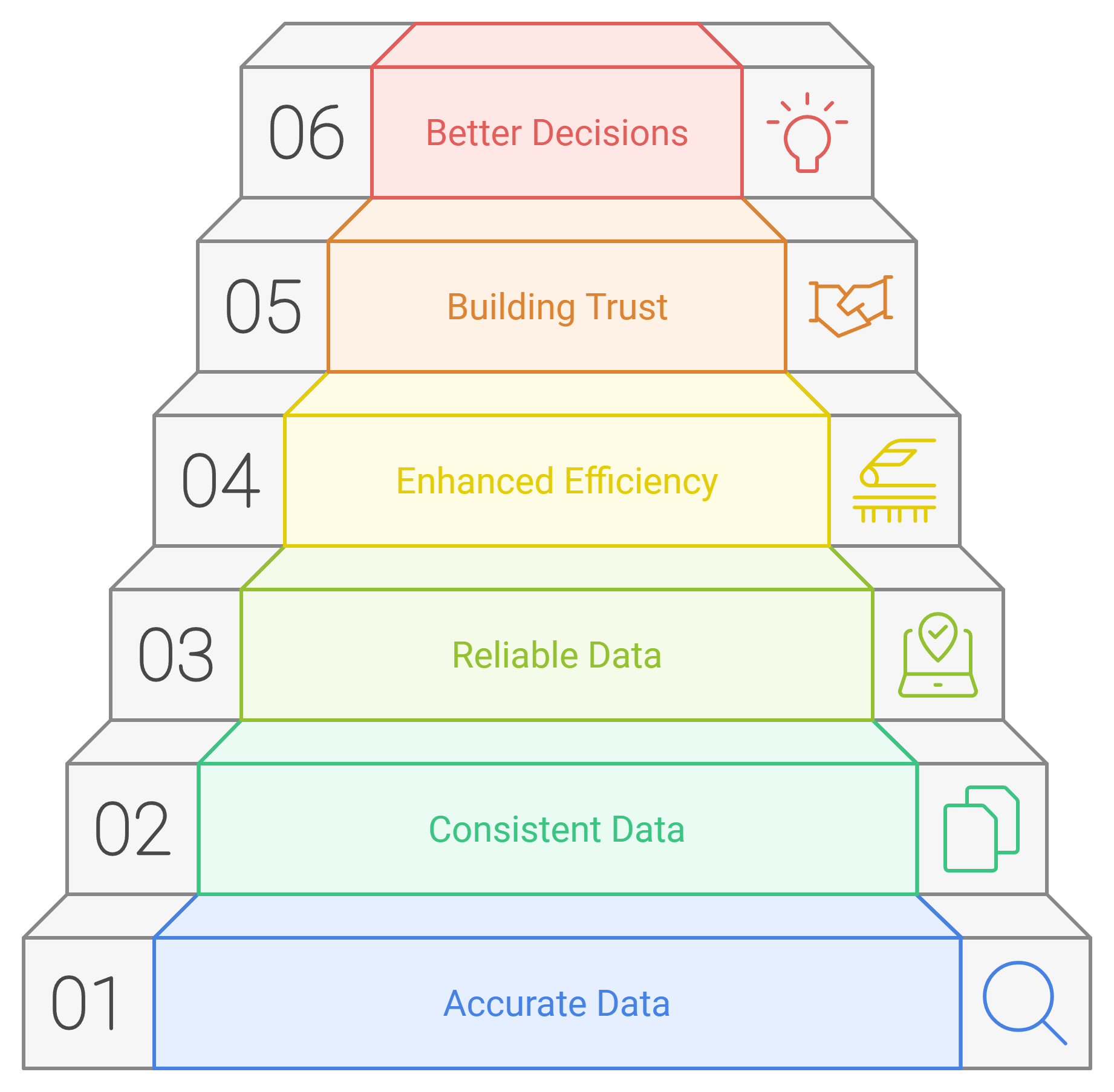
Key Dimensions of Data Quality
Understanding the key dimensions of data quality helps you evaluate and improve your data effectively. These dimensions include:
Accuracy: Ensures that data reflects real-world values. For example, customer contact details must be correct to avoid communication issues.
Consistency: Guarantees that data remains uniform across systems. Inconsistent data can lead to confusion and errors in reporting.
Completeness: Verifies that no critical information is missing. Incomplete data can hinder analysis and decision-making.
Timeliness: Confirms that data is up-to-date and relevant. Outdated data can result in poor decisions and missed opportunities.
Validity: Ensures that data adheres to predefined formats and rules. Invalid data can compromise the integrity of your systems.
By focusing on these dimensions, you can maintain high-quality data that supports your organization’s goals.
"High-quality data reduces the risk of errors and misinterpretations, ensuring better business outcomes and competitive advantage."
Tools and Techniques for Ensuring Data Accuracy
To maintain data accuracy, you need the right tools and techniques. Here are some effective methods:
Data Validation Tools: Use software to check for errors, inconsistencies, and missing values during data entry. These tools help prevent inaccuracies from entering your system.
Data Cleansing Software: Regularly clean your data to remove duplicates, correct errors, and standardize formats. This process improves the overall quality of your datasets.
Automated Workflows: Implement automation to streamline data collection and processing. Automation reduces human error and ensures consistency.
Metadata Management Tools: Leverage metadata to track the origin, usage, and changes in your data. This transparency enhances reliability and accountability.
Real-Time Monitoring Systems: Use tools that provide real-time insights into your data quality. These systems help you identify and address issues immediately.
Investing in these tools and techniques ensures that your data remains accurate and trustworthy.
Practical Tips for Monitoring Data Quality
Monitoring data quality is an ongoing process that requires consistent effort. Follow these practical tips to keep your data in top shape:
Establish Clear Metrics: Define measurable standards for data quality, such as error rates or completeness percentages. These metrics help you track progress and identify areas for improvement.
Conduct Regular Audits: Schedule periodic reviews of your data to detect and resolve issues. Audits ensure that your data remains accurate and compliant with policies.
Create a Feedback Loop: Encourage users to report errors or inconsistencies they encounter. This feedback helps you address problems quickly and improve data quality over time.
Train Your Team: Educate employees on the importance of data quality and their role in maintaining it. Training fosters a culture of accountability and attention to detail.
Leverage Dashboards: Use visual dashboards to monitor key data quality metrics. Dashboards provide a clear overview of your data’s health and highlight areas that need attention.
By implementing these tips, you can ensure that your data remains a valuable asset for your organization.
Data Security and Privacy Compliance
Data security and privacy compliance are essential for protecting sensitive information and maintaining trust with your stakeholders. Organizations must implement robust measures to safeguard data and adhere to legal requirements. By prioritizing security and compliance, you can reduce risks, avoid penalties, and ensure ethical data practices.
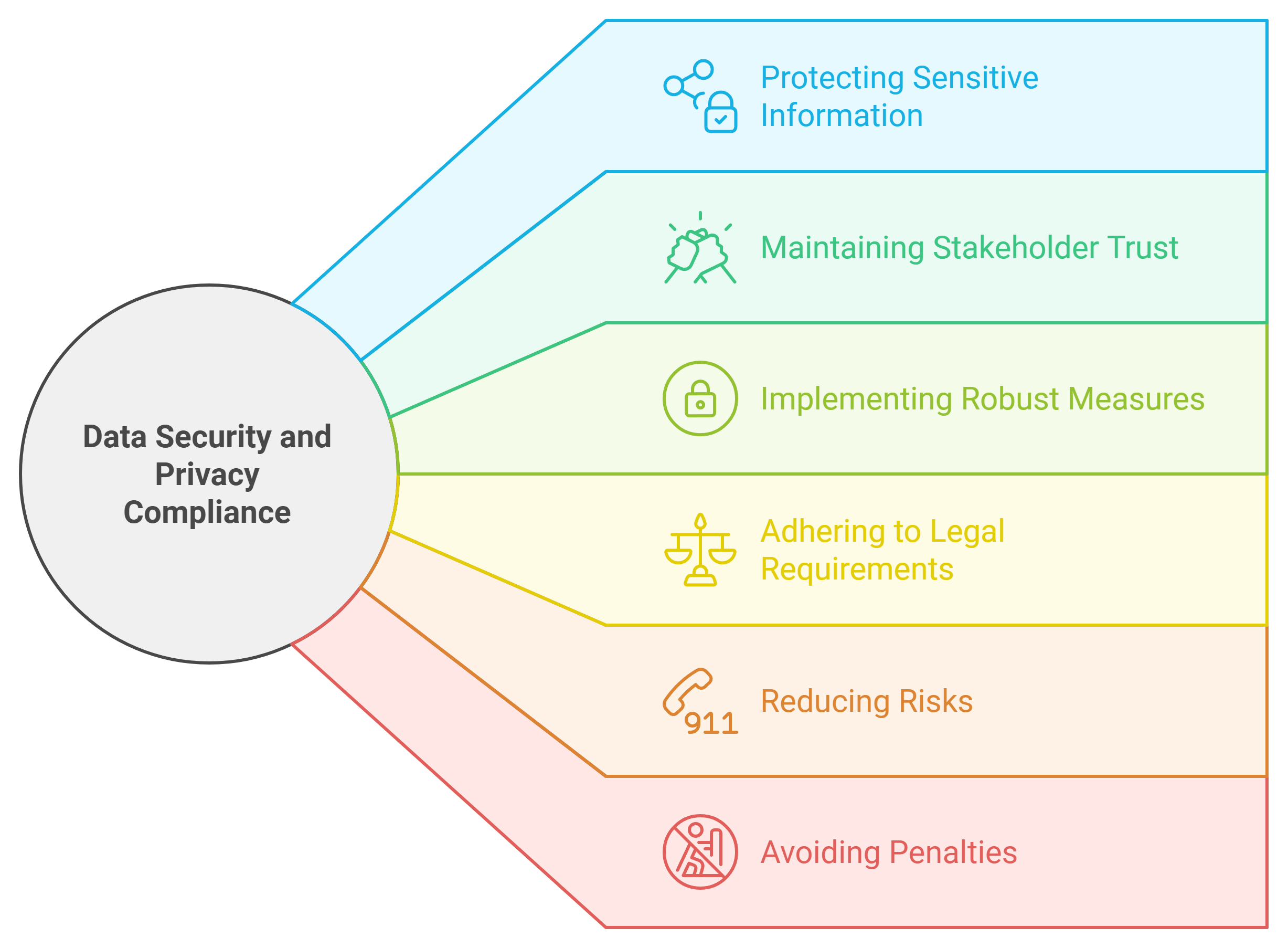
Importance of Protecting Sensitive Data
Sensitive data, such as personal information, financial records, and health details, requires the highest level of protection. Unauthorized access or breaches can lead to severe consequences, including financial losses, reputational damage, and legal penalties. Protecting this data is not just a regulatory requirement but also a moral obligation to your customers and employees.
"Data breaches cost companies millions of dollars annually and erode customer trust, making data security a top priority for modern organizations."
To protect sensitive data, you must implement strong security measures. Encryption, firewalls, and multi-factor authentication are essential tools for safeguarding information. Regularly updating your systems and conducting vulnerability assessments can help identify and address potential threats. By taking these steps, you create a secure environment that minimizes risks and ensures data integrity.
Overview of Regulatory Requirements (e.g., GDPR, CCPA)
Compliance with data protection regulations is critical for avoiding legal penalties and maintaining customer trust. Several key regulations govern how organizations handle data:
General Data Protection Regulation (GDPR): This European Union regulation mandates strict data protection and privacy measures. It requires organizations to obtain consent for data collection, ensure data accuracy, and provide individuals with control over their information.
California Consumer Privacy Act (CCPA): This U.S. regulation focuses on protecting consumer data. It grants individuals the right to know what data is collected, request its deletion, and opt out of data sales.
Health Insurance Portability and Accountability Act (HIPAA): This regulation applies to healthcare organizations and mandates stringent data privacy and security measures to protect patient information.
"Non-compliance with regulations like GDPR and CCPA can result in hefty fines and loss of customer trust, emphasizing the need for robust data governance practices."
Understanding these regulations helps you align your data management practices with legal requirements. By doing so, you not only avoid penalties but also demonstrate your commitment to ethical data handling.
Best Practices for Ensuring Compliance
Ensuring compliance with data security and privacy regulations requires a proactive approach. Follow these best practices to stay compliant and protect your organization:
Conduct Regular Audits: Periodically review your data management practices to identify gaps and ensure adherence to regulations.
Implement Access Controls: Restrict data access based on roles and responsibilities. Role-based access ensures that only authorized personnel can view or modify sensitive information.
Train Employees: Educate your team on data protection policies and the importance of compliance. Training reduces human errors and fosters a culture of accountability.
Use Data Encryption: Encrypt sensitive data to protect it from unauthorized access. Encryption ensures that even if data is intercepted, it remains unreadable.
Monitor Data Usage: Use monitoring tools to track how data is accessed and used. These tools help detect unusual activities and prevent potential breaches.
Stay Updated on Regulations: Keep track of changes in data protection laws and update your policies accordingly. Staying informed ensures that your practices remain compliant.
By adopting these practices, you can build a strong foundation for data security and privacy compliance. These measures not only protect your organization but also enhance trust with your customers and stakeholders.
Data Cataloging and Metadata Management
Data cataloging and metadata management are essential components of a successful data governance program. They provide the foundation for organizing, discovering, and understanding your organization's data assets. By implementing these practices, you can enhance data accessibility, improve decision-making, and ensure compliance with governance policies.
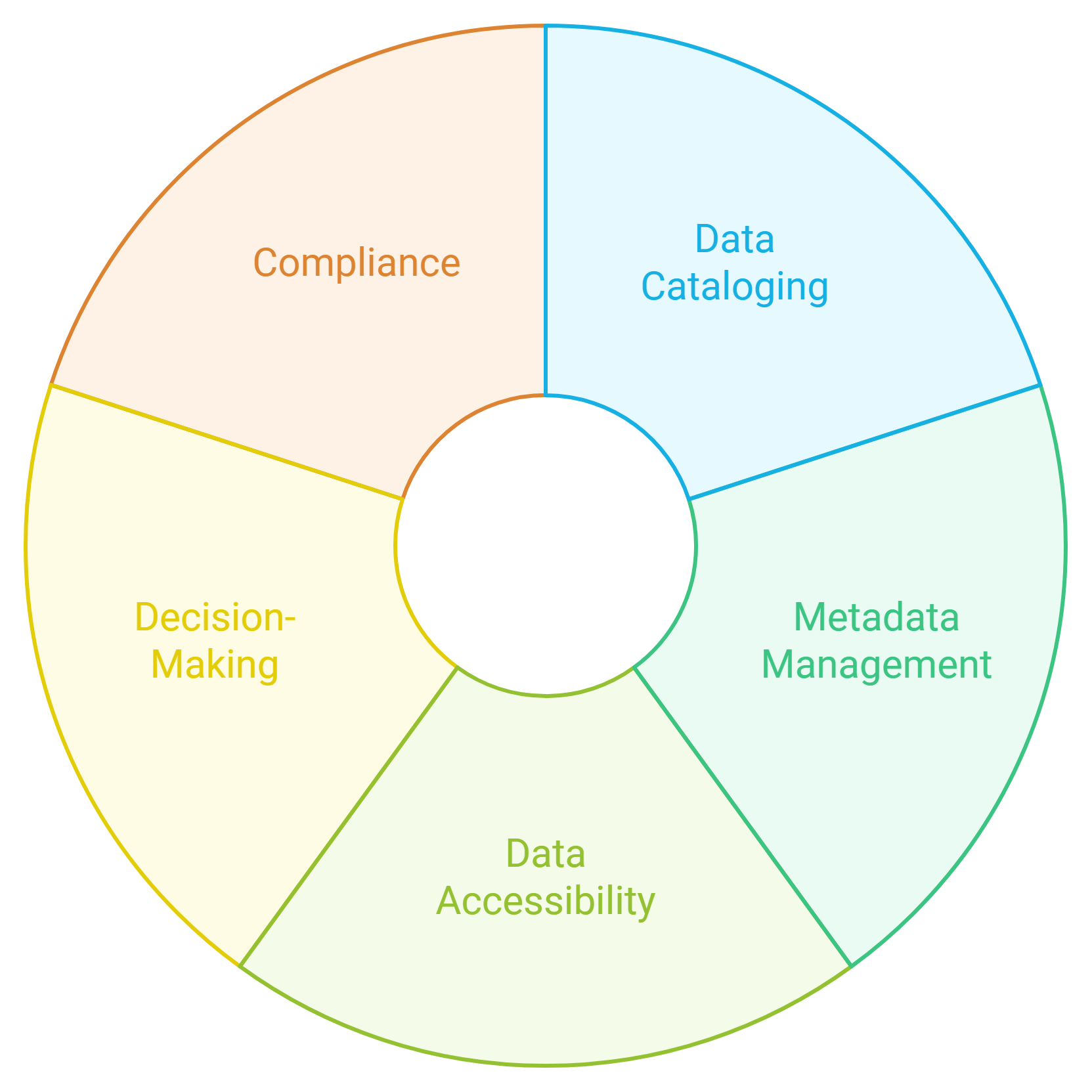
Role of Metadata in Effective Data Governance
Metadata serves as the backbone of data governance by providing critical context about your data. It describes the structure, origin, and usage of data, enabling you to understand its value and relevance. Without metadata, navigating through vast amounts of information becomes a daunting task.
Metadata helps you answer key questions about your data, such as:
Where did the data come from?
How has it been processed or transformed?
Who has access to it, and how is it being used?
For example, tools like Oracle Enterprise Metadata Management allow you to harvest and catalog metadata from various sources. These tools enable interactive searching, data lineage tracking, and impact analysis, making it easier to manage and govern your data effectively. By leveraging metadata, you can ensure consistency, reduce errors, and maintain compliance with regulations.
"Metadata is the glue that holds your data governance program together, providing the transparency and accountability needed for informed decision-making."
Benefits of a Centralized Data Catalog
A centralized data catalog acts as a single source of truth for your organization's data assets. It provides an indexed inventory of available data, making it easier for users to find and access the information they need. This centralization eliminates silos and fosters collaboration across teams.
Here are some key benefits of using a centralized data catalog:
Improved Data Discovery: A data catalog simplifies the process of finding relevant data by offering search functions and filters. For instance, Alation Data Catalog uses machine learning to index data sources and provide quick access to information.
Enhanced Collaboration: Centralized catalogs often include features like wikis and user comments, allowing teams to share insights and best practices. This fosters a culture of knowledge sharing and continuous improvement.
Data Lineage Tracking: Understanding the journey of your data is crucial for maintaining accuracy and compliance. Tools like IBM’s InfoSphere Information Server provide data lineage capabilities, helping you trace data from its origin to its current state.
Risk Mitigation: By cataloging sensitive data and applying appropriate controls, you can reduce the risk of unauthorized access or misuse. This is especially important for meeting regulatory requirements like GDPR and CCPA.
A centralized data catalog not only streamlines data management but also empowers your organization to make data-driven decisions with confidence.
Tools for Effective Metadata Management
Choosing the right tools for metadata management is critical for the success of your data governance program. These tools help you organize, analyze, and maintain metadata, ensuring that your data remains accurate and reliable.
Here are some popular tools for metadata management:
Informatica Metadata Management: This tool creates a knowledge graph of your data assets and their relationships. It uses AI and machine learning to provide insights into technical, business, and operational metadata.
Oracle Enterprise Metadata Management: This platform offers advanced algorithms for stitching together metadata assets from different providers. It supports semantic analysis and impact assessments, making it a powerful tool for governance.
IBM’s InfoSphere Information Server: This tool features a metadata repository that enables sharing and synchronization across multiple systems. It supports importing, exporting, and transferring metadata seamlessly.
Alation Data Catalog: Known for its user-friendly interface, this tool democratizes data by providing quick access to metadata alongside compliance flags and recommendations.
When selecting a tool, consider your organization's specific needs, such as the volume of data, regulatory requirements, and user expertise. The right tool will enhance your metadata management capabilities and support your overall data governance goals.
Data Access and Usage Controls
Data access and usage controls are vital for safeguarding sensitive information while ensuring that authorized users can access the data they need. Implementing these controls effectively protects your organization from breaches and unauthorized access, fostering trust and compliance.
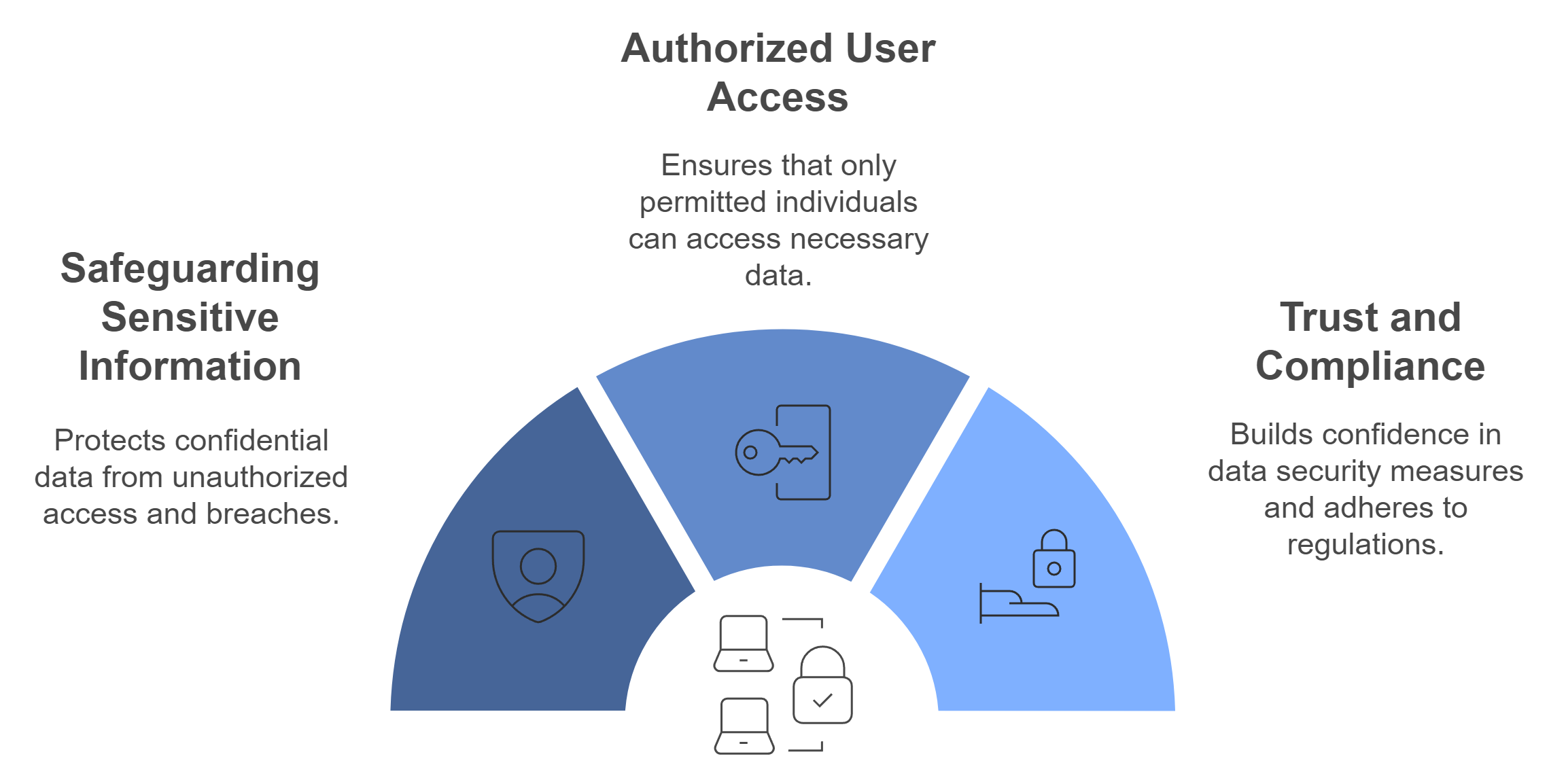
Importance of Role-Based Access
Role-based access control (RBAC) is a cornerstone of secure data management. It assigns permissions based on a user's role within the organization, ensuring that individuals only access the data necessary for their responsibilities. This approach minimizes risks by limiting exposure to sensitive information.
"Protecting data from unauthorized access and breaches is essential for maintaining data privacy."
RBAC enhances operational efficiency by streamlining access management. For example, when an employee changes roles, administrators can update their permissions without disrupting workflows. This system also reduces the likelihood of human error, as users cannot accidentally access or modify data outside their scope.
By implementing role-based access, you create a structured and secure environment where data remains protected while still being accessible to those who need it.
Balancing Accessibility with Security
Striking the right balance between accessibility and security is crucial. Overly restrictive controls can hinder productivity, while lax measures increase vulnerability to breaches. You must find a middle ground that protects data without impeding its usability.
Data accessibility ensures that authorized users can readily access the information they need. This availability supports informed decision-making and efficient operations. However, accessibility should never compromise security. Robust measures, such as encryption and multi-factor authentication, help maintain this balance.
"Developing robust security measures to protect against potential data breaches demands vigilance and expertise."
To achieve this balance, consider implementing tiered access levels. For instance, general employees might access aggregated data, while managers handle more detailed reports. This approach ensures that users have the right level of access for their roles, reducing risks while maintaining efficiency.
Tips for Implementing Access Controls
Implementing effective access controls requires a strategic approach. Follow these tips to enhance your data governance efforts:
Define Clear Policies: Establish strict and enforceable security policies for data access. These policies should outline who can access specific data and under what conditions.
Use Automation: Leverage tools to automate access management. Automation reduces manual errors and ensures consistency across the organization.
Regularly Review Permissions: Conduct periodic audits to ensure that access permissions align with current roles and responsibilities. Remove access for users who no longer need it.
Train Employees: Educate your team on the importance of access controls. Training fosters awareness and reduces the risk of accidental breaches.
Monitor Data Usage: Use monitoring tools to track how data is accessed and used. These tools help identify unusual activities and prevent potential threats.
"Creating strict and enforceable security policies can help organizations avoid threats."
By following these steps, you can implement access controls that protect your data while supporting your organization's goals. These measures not only enhance security but also promote a culture of accountability and trust.
Continuous Monitoring and Auditing
Continuous monitoring and auditing are essential for maintaining the integrity of your data governance program. These practices ensure that your data management processes remain effective, compliant, and aligned with organizational goals. By actively tracking performance and conducting regular assessments, you can identify gaps, address risks, and improve your overall data governance framework.
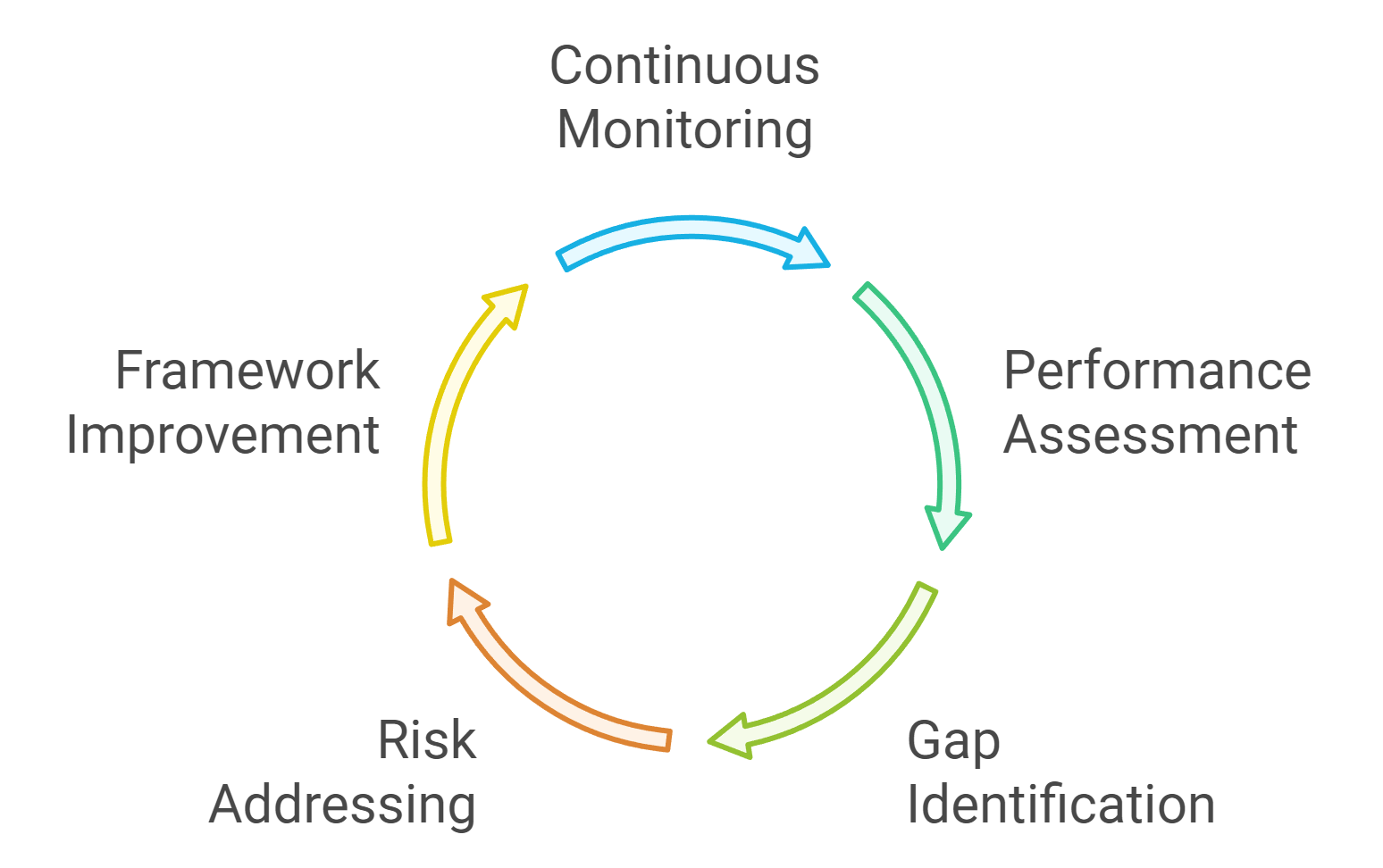
Why Ongoing Monitoring is Essential
Ongoing monitoring allows you to stay ahead of potential issues before they escalate into significant problems. It ensures that your data governance initiatives remain on track and adapt to evolving business needs. Regular monitoring also helps you maintain compliance with regulatory requirements, such as GDPR or CCPA, by ensuring that your data handling practices meet legal standards.
"Continuous monitoring and privacy impact assessments help ensure that data handling practices remain in line with regulatory requirements."
Monitoring provides real-time insights into your data quality, security, and usage. For example, it can help you detect unauthorized access or unusual activity, enabling you to take immediate action. This proactive approach minimizes risks and protects sensitive information. Additionally, continuous monitoring fosters accountability by keeping all stakeholders informed about the status of your data governance efforts.
Tools for Tracking Data Governance Metrics
To effectively monitor your data governance program, you need the right tools. These tools help you track key metrics, identify trends, and measure the success of your initiatives. Here are some popular options:
Data Governance Software: Platforms like Collibra and Informatica provide comprehensive solutions for monitoring compliance, tracking data quality, and managing metadata.
Audit Management Tools: Tools such as AuditBoard and Resolver streamline the auditing process by automating data collection, analysis, and reporting.
Real-Time Monitoring Systems: Solutions like Splunk and SolarWinds offer real-time insights into data usage and security, helping you detect and address issues promptly.
Data Quality Tools: Applications like Talend and Trifacta focus on ensuring data accuracy, consistency, and completeness through validation and cleansing processes.
These tools not only simplify monitoring but also enhance your ability to make informed decisions. For instance, governance software can audit data access activity, confirm data security, and handle data subject access requests efficiently.
"Governance software checks that compliance systems are working effectively."
By leveraging these tools, you can ensure that your data governance program operates smoothly and delivers measurable results.
Steps to Conduct Regular Audits
Regular audits are a cornerstone of effective data governance. They help you evaluate the effectiveness of your controls, identify areas for improvement, and ensure compliance with regulations. Follow these steps to conduct successful audits:
Define Audit Objectives: Clearly outline what you aim to achieve with the audit. Focus on specific areas, such as data quality, security, or compliance.
Gather Documentation: Collect all relevant records, including data policies, access logs, and compliance reports. Accurate documentation ensures audit readiness.
Assess Current Practices: Evaluate your existing data governance processes to identify strengths and weaknesses. Look for gaps in compliance or inefficiencies in workflows.
Engage Stakeholders: Involve key stakeholders, such as data stewards, IT teams, and compliance officers. Their input provides valuable insights and ensures a comprehensive assessment.
Use Audit Tools: Leverage software to automate data collection and analysis. Tools like Resolver simplify the process and improve accuracy.
Report Findings: Summarize the audit results in a clear and actionable report. Highlight areas for improvement and recommend specific steps to address them.
Implement Changes: Act on the audit findings by updating policies, improving controls, or providing additional training. Regularly review progress to ensure continuous improvement.
"Regular data audits and assessments are crucial to maintaining data quality, accuracy, and security."
By conducting regular audits, you create a robust system for evaluating and enhancing your data governance program. These audits not only ensure compliance but also build trust with stakeholders by demonstrating your commitment to responsible data management.
Training and Change Management
Training and change management are essential for embedding data governance practices into your organization. They ensure that employees understand their roles, adapt to new processes, and embrace a culture of accountability. Without proper training and change management, even the most well-designed data governance program can fail to deliver results.
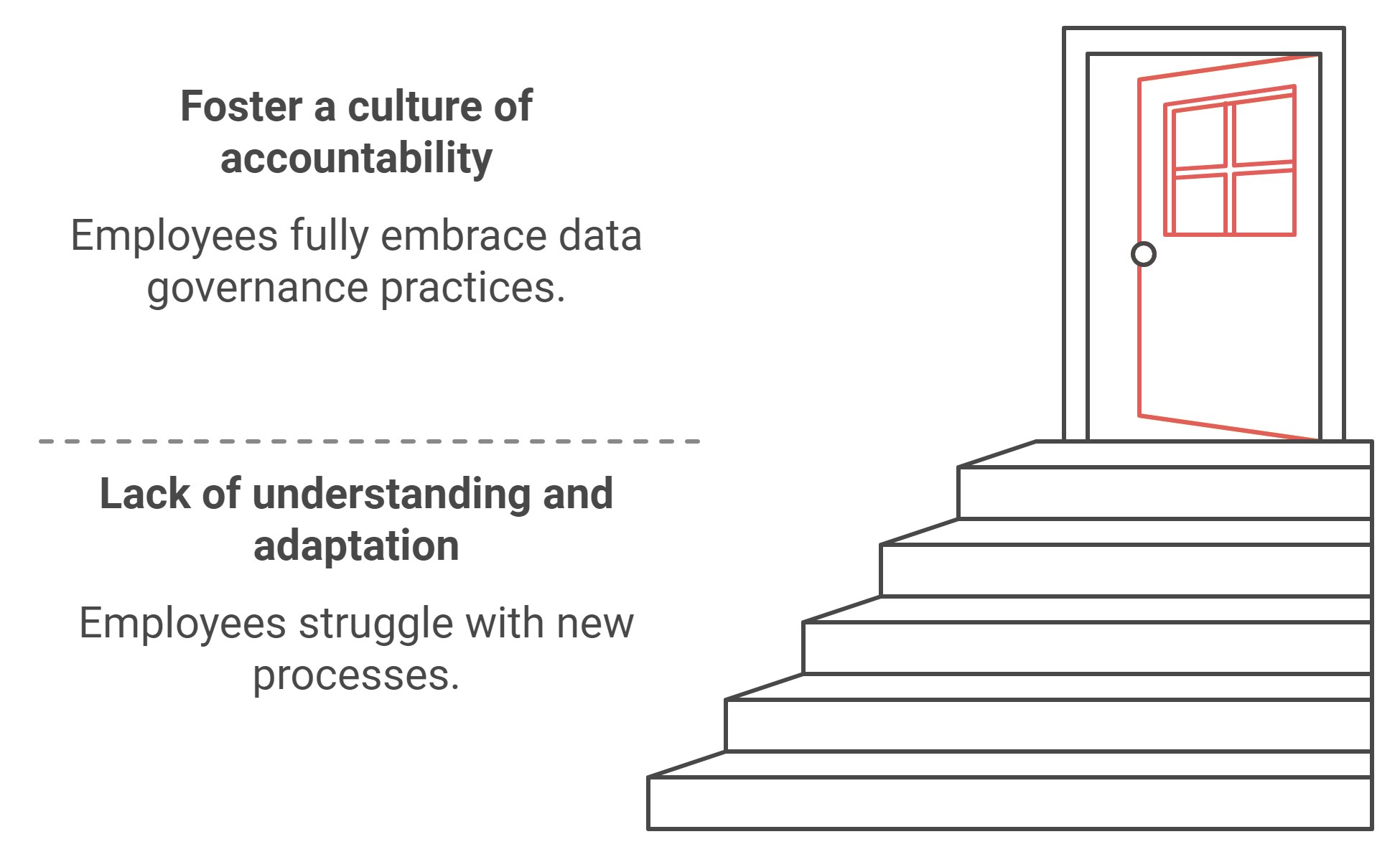
Building a Data-Driven Culture
A data-driven culture prioritizes informed decision-making based on accurate and reliable data. Building this culture requires more than just implementing tools or policies. It demands a shift in mindset across all levels of your organization. Employees must view data as a strategic asset and understand its value in achieving business goals.
To foster a data-driven culture, you should:
Promote Awareness: Communicate the importance of data governance to all employees. Highlight how it impacts their daily tasks and contributes to organizational success.
Lead by Example: Encourage leaders to model data-driven behaviors. When executives rely on data for decisions, it inspires others to follow suit.
Celebrate Successes: Share stories of how data-driven decisions have led to positive outcomes. Recognizing these achievements reinforces the value of data governance.
"Organizations that embrace a data-driven culture experience improved decision-making, operational efficiency, and competitive advantage."
Building this culture takes time and consistent effort. However, the long-term benefits, such as enhanced trust in data and better collaboration, make it a worthwhile investment.
Importance of Employee Training
Employee training is the cornerstone of any successful data governance program. It equips your team with the knowledge and skills needed to manage data responsibly and effectively. Without proper training, employees may struggle to comply with policies or use tools correctly, leading to errors and inefficiencies.
Training programs should focus on:
Data Literacy: Teach employees how to interpret, analyze, and use data in their roles. This foundational skill ensures that everyone can contribute to data-driven initiatives.
Governance Policies: Educate employees on your organization's data policies and standards. Clear understanding reduces the risk of non-compliance and misuse.
Tools and Technology: Provide hands-on training for data governance tools. Familiarity with these tools enhances productivity and ensures consistent application of governance practices.
A recent survey revealed that learning activities aimed at enhancing data management skills significantly improve the effectiveness of governance programs. By investing in training, you empower your team to uphold high standards and drive better outcomes.
"Well-trained employees are the backbone of effective data governance, ensuring that policies and practices are consistently applied."
Strategies for Managing Organizational Change
Implementing a data governance program often requires significant changes to processes, roles, and responsibilities. Managing this change effectively is crucial for ensuring a smooth transition and long-term success. Resistance to change can derail your efforts, so you must address it proactively.
Here are some strategies to manage organizational change:
Engage Stakeholders Early: Involve key stakeholders from the beginning. Their input and support can help shape the program and build trust among employees.
Communicate Clearly: Share the vision, goals, and benefits of the data governance program. Transparent communication reduces uncertainty and fosters buy-in.
Provide Ongoing Support: Offer resources, such as training sessions and help desks, to assist employees during the transition. Continuous support ensures that they feel confident in adapting to new processes.
Celebrate Milestones: Acknowledge progress and achievements throughout the implementation process. Celebrating milestones keeps morale high and reinforces commitment to the program.
Monitor and Adjust: Regularly assess the impact of changes and gather feedback from employees. Use this information to refine your approach and address any challenges.
"Effective change management transforms resistance into acceptance, paving the way for a successful data governance program."
By following these strategies, you can navigate the complexities of organizational change and create an environment where data governance thrives.
The 10 critical features outlined in this blog are essential for achieving Effective Data Governance. They provide a roadmap to ensure your organization manages data responsibly, securely, and efficiently. By integrating people, processes, and technology, you create a holistic approach that enhances data quality, compliance, and decision-making. Assess your current efforts, identify gaps, and take actionable steps to improve. Effective Data Governance not only minimizes risks but also unlocks the full potential of your data, driving long-term business value, operational efficiency, and stakeholder trust.
See Also
Unveiling Key Components of Data Governance Strategies
Embedding Data Leadership Within Corporate Governance Frameworks
Evaluating Effectiveness of Data Leadership Programs
